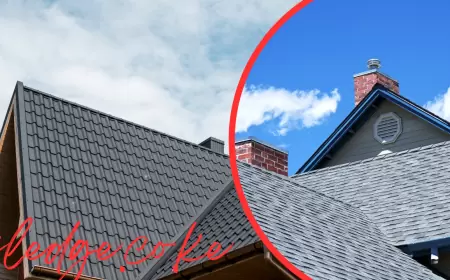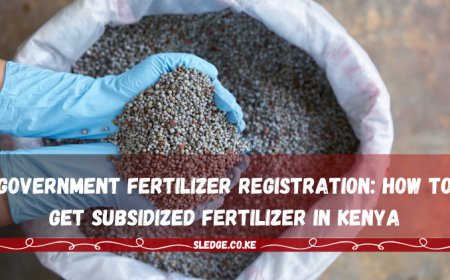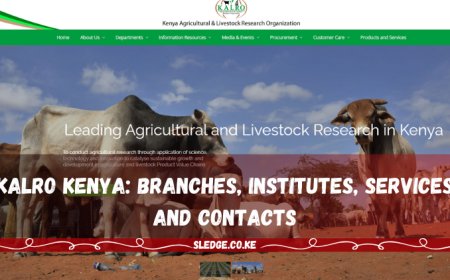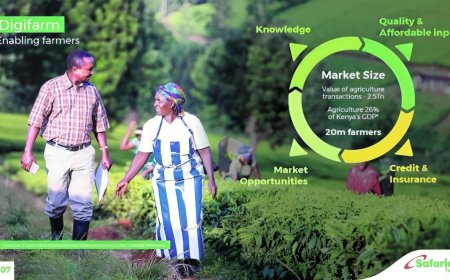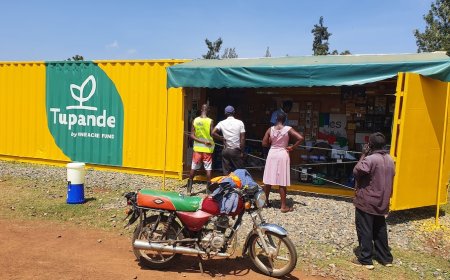Full List of All Nairobi County Districts In Kenya In 2024
Explore the Full List of All Nairobi County Districts In Kenya, From historical central areas to diverse residential neighbourhoods and the resilience of informal settlements. Discover Nairobi's dynamic urban landscape
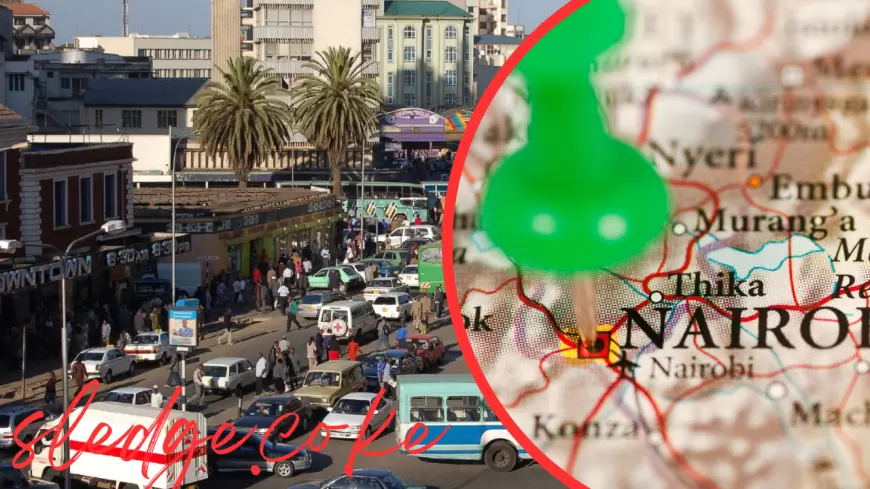
Nairobi, often referred to as the "Green City in the Sun", is much more than Kenya's bustling capital. It's a vibrant metropolis, a melting pot of cultures, languages, and lifestyles that converge to create a unique urban tapestry. This city, pulsating with life and diversity, stands as a testament to the rich history and dynamic future of Kenya. As we embark on this exploratory journey through Nairobi's distinct districts, we're not just traversing geographical boundaries; we're delving into the heart and soul of a city that's as varied as it is captivating.
From the central business district's towering skyscrapers to the colourful streets of its residential areas, each district tells its own story. These stories are not just about the architecture or the layout of the streets; they're about the people, their heritage, and their aspirations. In this article, we aim to unravel these stories to paint a picture of Nairobi that goes beyond the common narratives. We will explore the intricacies of its central districts, dive into the residential havens that offer a glimpse into the daily lives of Nairobians, and confront the stark realities of its informal settlements. Through this journey, we aim to showcase Nairobi in all its complexity and charm, providing a comprehensive understanding of a city that continues to evolve and surprise.
READ ALSO:Top 10 Taxi Apps in Kenya 2024: A Comprehensive Guide
The Heart of Nairobi – Central Districts and Their Significance
Nairobi, a city woven with historical threads and modern aspirations, is a living tapestry of Kenya's colonial past and its forward-looking future. The central districts of Nairobi form the core of this complex urban landscape, each district pulsating with its unique rhythm and narrative.
Nairobi's journey from a colonial railway depot to the bustling capital of Kenya is etched in the streets and structures of its central districts. These districts, once the focal point of colonial administration, have transformed into hubs of commerce, governance, and culture. The colonial legacy is still visible in the architecture and street names, reminiscent of a bygone era when Nairobi was a segregated city, not meant for its African inhabitants.
As Nairobi gained independence in 1963, the process of "Africanisation" began. This era marked a significant shift in the city's identity, with street names and landmarks being renamed to reflect the new African elite and the dominant Kikuyu ethnic group. This renaming was more than a symbolic act; it was a reclamation of space and identity, a move towards an African Nairobi that represented its people.
Key Districts: Pillars of Nairobi's Urban Fabric
The central districts, each with its distinct character, play a vital role in Nairobi's urban narrative:
- CBD (Central Business District): The heart of Nairobi's economic activity, characterized by skyscrapers, bustling streets, and a mix of colonial-era buildings and modern architecture. It's a hub for businesses, government offices, and a thriving informal sector.
- Westlands: Once a residential area, now transformed into a commercial hub with high-rise buildings, shopping malls, and vibrant nightlife. It's a melting pot of cultures, showcasing Nairobi's dynamic urban life.
- Kilimani: Known for its cosmopolitan vibe, Kilimani is a mix of residential and commercial spaces. It's a district where modernity meets tradition, reflecting Nairobi's evolving urban landscape.
- Kibera: In contrast to the affluence of areas like Westlands, Kibera, Africa's largest slum, tells a different story of Nairobi. It's a place where resilience and community spirit shine through despite the challenges of poverty and inadequate infrastructure.
Cultural and Economic Impacts
These central districts are not just physical spaces; they are economic engines and cultural melting pots. The CBD, for instance, drives Nairobi's economy, hosting numerous businesses and government institutions. Westlands and Kilimani, with their blend of residential and commercial developments, contribute to the city's growing cosmopolitan culture. These areas are also home to various cultural and recreational venues, making them pivotal in shaping Nairobi's urban lifestyle.
Kibera, on the other hand, offers a stark contrast. Despite its challenges, it's a hub of creativity and innovation, where small businesses thrive, and community initiatives aim to improve living conditions. This district, often overlooked, is integral to understanding the full spectrum of Nairobi's urban experience.
Residential Districts
Nairobi, a city of stark contrasts and diverse experiences, offers a plethora of residential districts, each with its unique charm and character. These areas, ranging from luxurious suburbs to vibrant, mixed communities, provide a glimpse into the varied lifestyles and socio-economic dynamics of Nairobi's residents.
- Muthaiga: Often dubbed the 'Beverly Hills of Nairobi,' Muthaiga is a symbol of luxury and exclusivity. It's home to some of Kenya's wealthiest individuals and expatriates. The area is characterized by gated, secure homes and lush, tree-lined streets, offering tranquillity and luxury. The presence of top international schools makes it an ideal choice for families.
- Parklands: Just north of the CBD, Parklands is a blend of residential and commercial spaces. It's a melting pot of cultures, home to Kenyan, Indian, and Middle Eastern communities. The district offers a range of accommodations, from apartments to standalone homes, catering to young professionals and families alike. Its proximity to healthcare facilities and recreational areas like Karura Forest adds to its appeal.
- Westlands: A stone's throw away from the CBD, Westlands combines the hustle of city life with residential comfort. Known for its vibrant nightlife, restaurants, and shopping centres, it's a favourite among young professionals. The area also offers quieter parts like Spring Valley, known for detached houses and bungalows, providing a balance between urban life and tranquillity.
- Kilimani and Hurlingham: These neighbourhoods are popular for their high-rise apartment complexes, complete with modern amenities like swimming pools, gyms, and health clubs. They are bustling with youthful energy, thanks to the presence of international schools, shopping malls, and entertainment options. Kilimani, in particular, stands out for its trendy boutiques and contemporary art scene, attracting city trendsetters.
- Lavington and Kileleshwa: Ideal for families, these areas offer a serene environment with elegant homes and spacious apartments. Their leafy streets provide a peaceful retreat from the city's buzz, making them sought-after residential options for those who value privacy and a quiet lifestyle.
Community and Lifestyle
Each of these districts offers more than just housing; they provide a sense of community and lifestyle that reflects Nairobi's diversity. For instance, Muthaiga's exclusivity contrasts with the multicultural vibrancy of Parklands and Westlands. Kilimani and Hurlingham cater to a younger, more dynamic crowd. At the same time, Lavington and Kileleshwa are havens for families seeking a blend of urban and suburban living.
Housing Dynamics in Nairobi's Residential Districts
The real estate landscape in these areas is as varied as their character. Muthaiga and Westlands, with their high-end properties, cater to the affluent market. In contrast, Kilimani and Hurlingham offer a mix of luxury and mid-range options suitable for a broader demographic. Lavington and Kileleshwa, with their focus on family-friendly environments, have seen a steady demand for spacious homes and apartments.
List of All Nairobi County Districts In Kenya In 2024
| Constituency | Population | County | Wards | Area (sq. kms) | Major Ethnic Group |
|---|---|---|---|---|---|
| Westlands | N/A | Nairobi | N/A | 72.4 | Cosmopolitan |
| Dagoretti North | 151,978 | Nairobi | 5 | 29 | Cosmopolitan |
| Dagoretti South | 178,691 | Nairobi | 5 | 25 | Cosmopolitan |
| Langata | 223,000 | Nairobi | N/A | 223 | Cosmopolitan |
| Kibra | 178,284 | Nairobi | 5 | 12 | Cosmopolitan |
| Roysambu | 202,284 | Nairobi | 5 | 49 | Cosmopolitan |
| Kasarani | 200,984 | Nairobi | 5 | 153 | Cosmopolitan |
| Ruaraka | 192,620 | Nairobi | 5 | 7.2 | Cosmopolitan |
| Embakasi (East) | 163,858 | Nairobi | 5 | 65 | Cosmopolitan |
| Embakasi (West) | 187,020 | Nairobi | 4 | 9 | Cosmopolitan |
| Embakasi (Central) | 185,948 | Nairobi | 5 | 14 | Cosmopolitan |
| Embakasi (North) | 181,388 | Nairobi | 5 | 6 | Cosmopolitan |
| Embakasi (South) | 201,042 | Nairobi | 5 | 12 | Cosmopolitan |
| Makadara | 160,434 | Nairobi | 4 | 13 | Cosmopolitan |
| Kamukunji | 211,991 | Nairobi | 5 | 9 | Cosmopolitan |
| Starehe | 166,041 | Nairobi | 6 | 20 | Cosmopolitan |
| Mathare | 193,416 | Nairobi | 6 | 3 | Cosmopolitan |
Informal Settlements and Their Challenges
Nairobi, a city of contrasts, is not just made up of affluent suburbs and bustling commercial centres. It also includes informal settlements, which present a different yet critical aspect of the city's urban landscape. These areas, often overlooked, are integral to understanding Nairobi's complexity and diversity.
- Kibera: Africa's largest slum, Kibera, stands in stark contrast to Nairobi's wealthier districts. Home to hundreds of thousands, Kibera is a vibrant community where resilience and resourcefulness are a way of life. Despite the challenges, the spirit of entrepreneurship thrives, with small businesses and local initiatives driving the community's economy.
- Mukuru: Similar to Kibera, Mukuru is another large informal settlement in Nairobi. Life here is marked by high population density, inadequate sanitation, and limited access to basic services. Yet, the community's strength lies in its solidarity and the collective efforts to improve living conditions.
Health and Infrastructure
The health and infrastructure challenges in these informal settlements are significant. For instance, according to research by the African Population and Health Research Center, the under-five mortality rate in Nairobi’s informal settlements in 2012 exceeded the city’s overall rate in 2008-09 (79.8 per 1,000 vs. 63.4 per 1,000). This disparity highlights the urgent need for improved healthcare and sanitation facilities.
Access to clean water and safe sanitation remains a critical issue. Many residents rely on informal providers for basic services, often at a higher cost and lower quality. The sewerage coverage in Nairobi was only 51% as of 2019, with many informal settlements lacking proper waste management systems.
Government and NGO Efforts
Efforts to improve living conditions in these areas have seen varying degrees of success. Non-governmental organizations and community-based initiatives play a vital role in providing essential services like healthcare, education, and clean water. Government programs, while present, often face challenges in implementation and sustainability.
One notable effort is the introduction of automated water dispensing units in some informal settlements, which aim to provide more reliable and affordable access to clean water. However, the success of such initiatives is contingent on continuous support and effective management.
READ ALSO: Fadhili Loan App 2024 Kenya: Eligibility, Application Process, Loan Terms , Rates & Repayment
Frequently Asked Questions about Nairobi's Districts
What are the safest districts in Nairobi for expatriates and tourists?
- Areas like Muthaiga, Westlands, and Kilimani are known for their safety, with private security and proximity to international amenities, making them popular among expatriates and tourists.
How does the cost of living vary across different districts in Nairobi?
- The cost of living can vary significantly. Affluent areas like Muthaiga and Runda are on the higher end. At the same time, districts like Kibera and Mukuru are much lower but come with their own set of challenges.
What are the best districts in Nairobi for real estate investment?
- Westlands and Kilimani are currently hotspots for real estate investment due to their central location and blend of residential and commercial developments.
How do the educational facilities differ across Nairobi's districts?
- More affluent districts boast a range of high-quality international schools. At the same time, informal settlements often rely on community-run schools and NGO-supported educational initiatives.
Conclusion
Nairobi is a city of contrasts, where each district contributes its unique thread to the city's rich tapestry. From the affluent suburbs of Muthaiga to the bustling, diverse communities of Westlands and Kilimani, each area offers a glimpse into the varied lifestyles of Nairobi's residents. In stark contrast, the informal settlements like Kibera and Mukuru, while facing significant challenges, display an unparalleled spirit of resilience and community strength.
This exploration of Nairobi's districts reveals the city's complexity, a place where history, culture, and modern aspirations intertwine. As Nairobi continues to grow and evolve, understanding its diverse districts is key to appreciating the city's full narrative. It's a narrative that encompasses the elegance of its affluent neighbourhoods, the vibrancy of its mixed communities, and the resilience of its informal settlements.
We encourage you to explore Nairobi's districts themselves, engage with the city's diverse communities, and experience firsthand the unique charm that each area offers. Whether you're a resident, a visitor, or simply an urban enthusiast, Nairobi's mosaic of districts promises a rich, multifaceted experience.













































